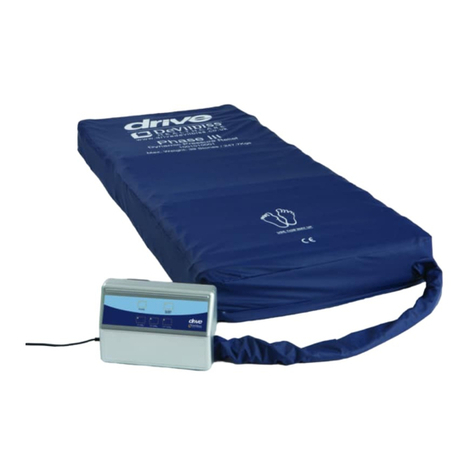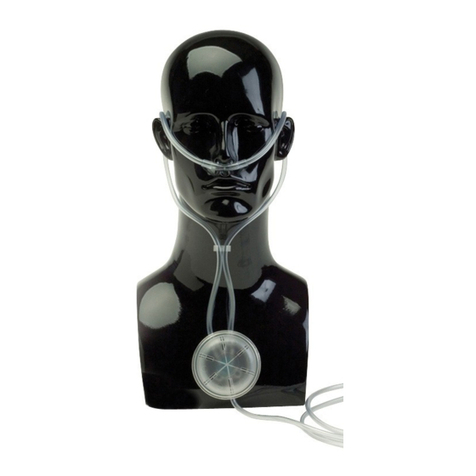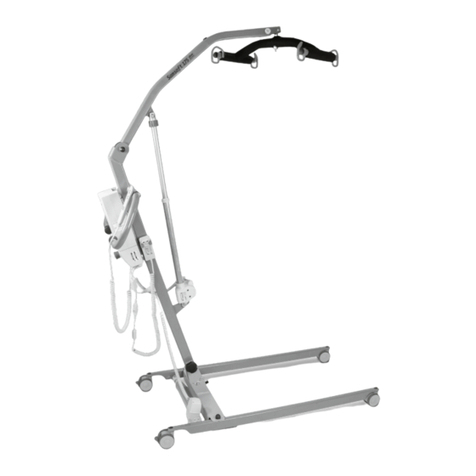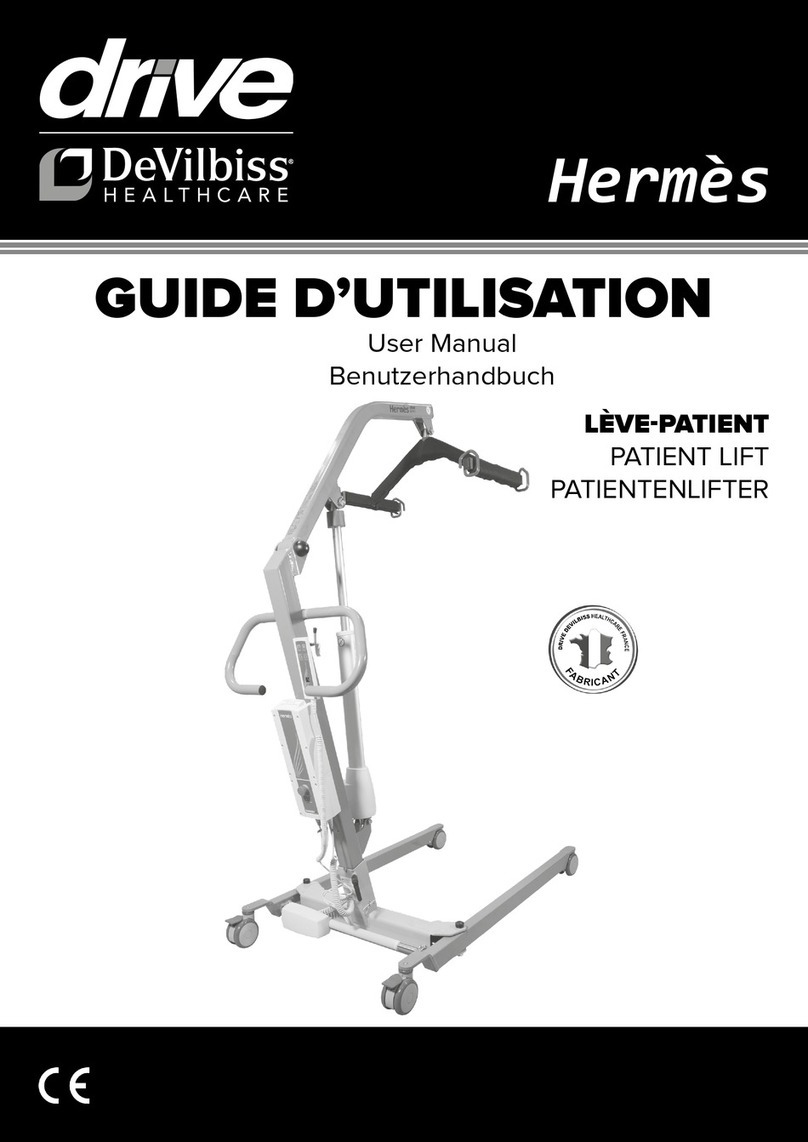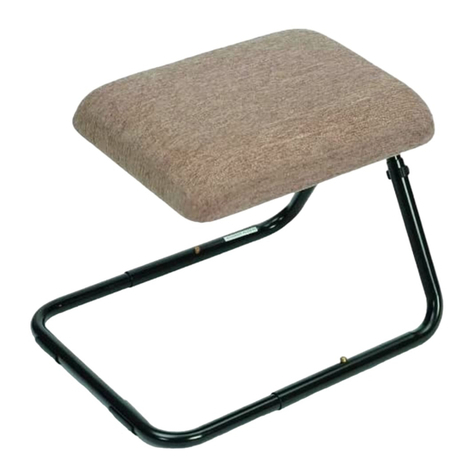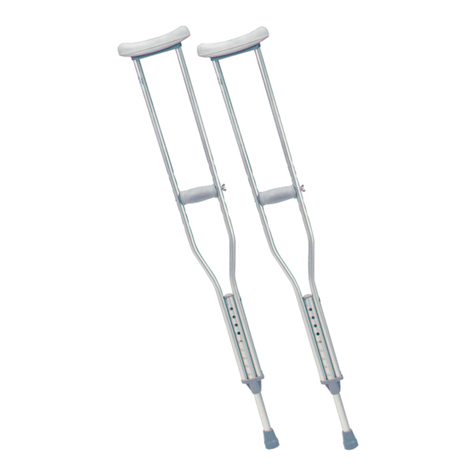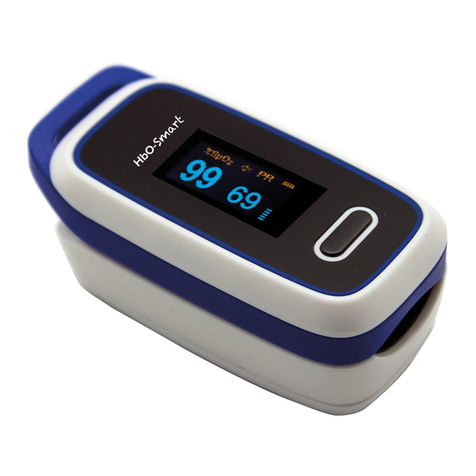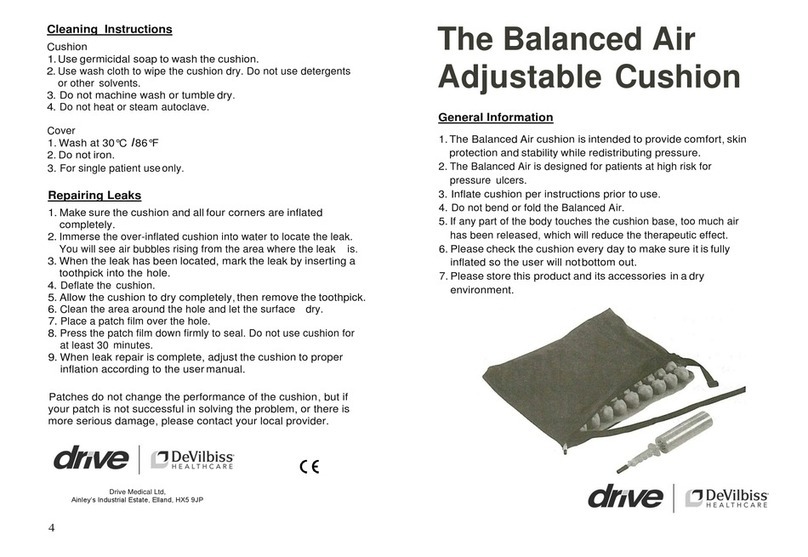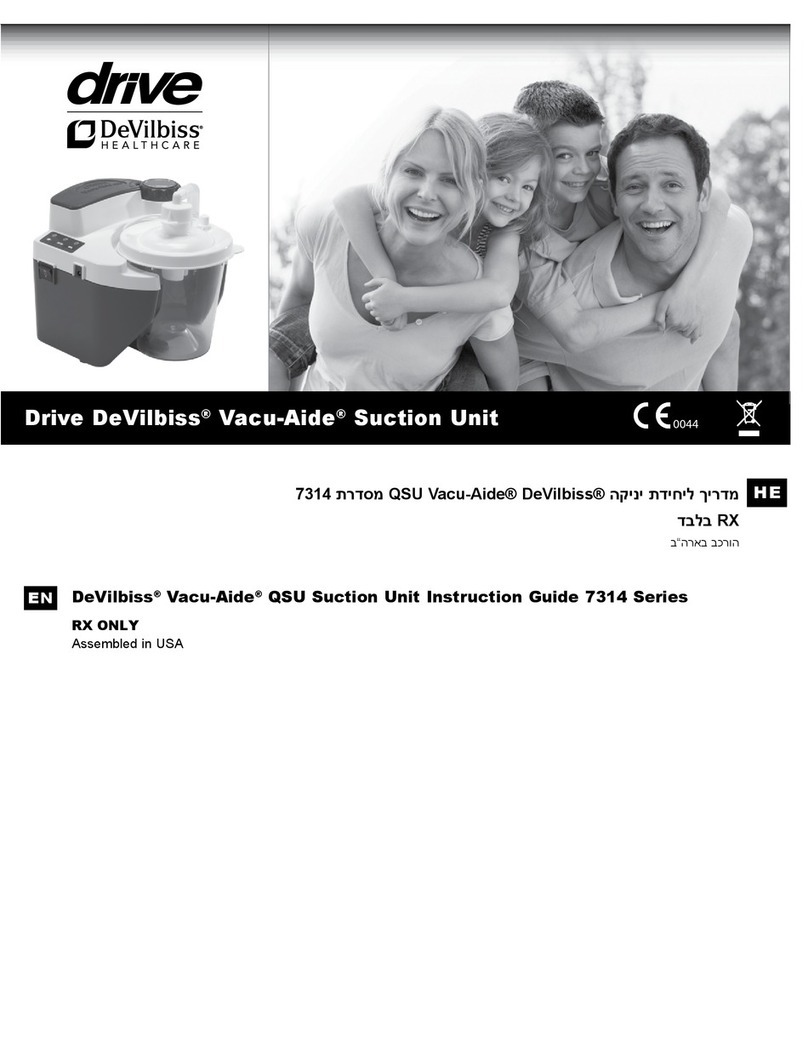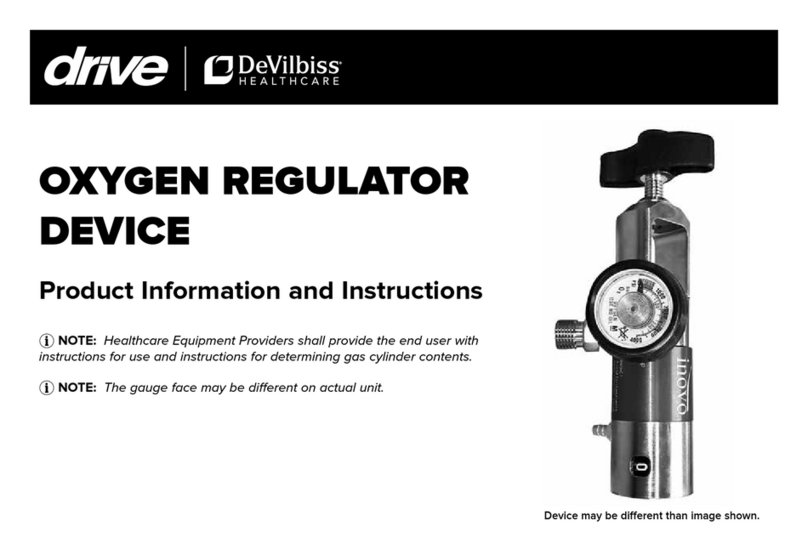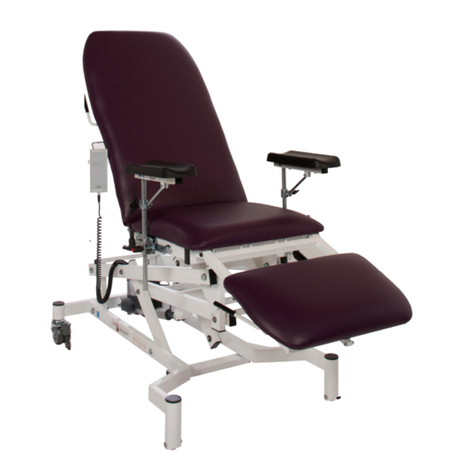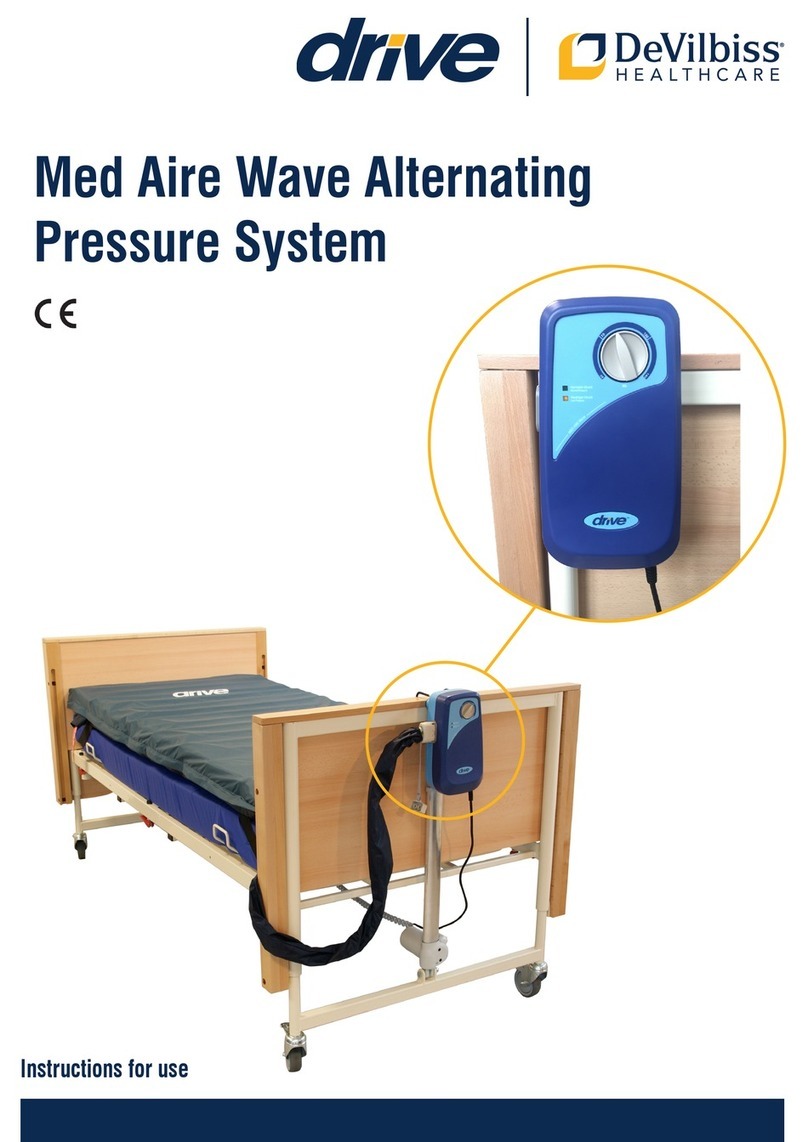
3
LT-2329
GENERAL INFORMATION
INTRODUCTION
This service manual was designed to provide DeVilbiss Healthcare qualied
service technicians and homecare providers with the proper maintenance,
service, safety, and repair procedures for the Drive DeVilbiss Oxygen
Concentrator.
Read and understand all the information contained in this service manual before
attempting to operate or perform any maintenance on the concentrator.
An oxygen concentrator is a device that delivers highly concentrated oxygen for
therapeutic applications.
Room air is a mixture of 78% nitrogen, 21% oxygen, 1% argon and other gases.
The concentrator draws in room air, separates the nitrogen from the oxygen, and
delivers concentrated oxygen to the patient through an oxygen port.
For more in-depth classroom type training, contact the Respiratory Technical
Service Department at 1-800-338-1988 (814-443-4881).
NOTE–DeVilbiss reserves the right to alter or change the design of the Drive
DeVilbiss Oxygen Concentrator series. Hence, slight differences in construction
or components may exist between the unit in hand and what is described in this
manual.
IMPORTANT SAFEGUARDS
DANGER
NO SMOKING
Read all instructions before operating the oxygen concentrator. Important
information is highlighted by these terms:
DANGER: Indicates an imminently hazardous situation which could result
in death or serious injury to the user or operator if not avoided.
WARNING: Safety information for hazards that might cause serious injury
or death.
CAUTION–Information for preventing damage to the product.
NOTE–Information to which you should pay special attention.
SAFETY PRECAUTIONS AND GENERAL
WARNINGS:
A warning indicates the possibility of serious injury or death to the
user or the operator.
• Oxygen causes rapid burning. Do not smoke while your oxygen
concentrator is operating, or when you are near a person utilizing oxygen
therapy. Keep the oxygen concentrator and cannula at least 6.5 feet (2 m)
from hot, sparking objects or naked sources of ame.
• Oxygen makes it easier for a re to start and spread. Do not leave the
nasal cannula or mask on bed coverings or chair cushions if the oxygen
concentrator is turned on but not in use, the oxygen will make the materials
ammable. Turn the oxygen concentrator off when not in use to prevent
oxygen enrichment.
• Keep the oxygen concentrator and cannula at least 6.5 feet (2 m) from hot,
sparking objects or naked sources of ame.
• Open ames during oxygen therapy are dangerous and are likely to result
in re or death. Do not allow open ames within 6.5 feet (2 m) of the
oxygen concentrator or any oxygen carrying accessories.
• Locate oxygen tubing and power supply cords to prevent tripping hazards
and reduce the possibility of entanglement or strangulation.
• Equipment not suitable for use in the presence of a ammable anesthetic
mixture with air or with oxygen or nitrous oxide.
• Smoking during oxygen therapy is dangerous and is likely to result in facial
burns or death. Do not allow smoking within the same room where the
oxygen concentrator or any oxygen carrying accessories are located. If you
intend to smoke, you must always turn the oxygen concentrator off, remove
the cannula and leave the room where either the cannula or mask or the
oxygen concentrator is located. If unable to leave the room, you must wait
10 minutes after you have turned off the oxygen concentrator before
smoking.
• See instructions for use regarding re propagation prevention.
• The DeVilbiss 1025 oxygen concentrator is equipped with a re mitigating
outlet tting that prevents propagation of re into the unit.
• The surface temperature of the exhaust vents on the bottom of the unit
may exceed 105.8˚F (41˚C) under certain conditions.
• When device is used under extreme operating conditions, the temperature
near the exhaust vents on the bottom of the unit may reach 138.2˚F (59˚C).
Keep body parts a minimum of 30” (76.2 cm) away from this area.
• Electric shock hazard. Do not plug the concentrator into an AC outlet if
cabinet is broken. Do not remove cabinet. The cabinet should only be
removed by a qualied DeVilbiss homecare provider.
• Ensure the power cord is fully inserted into the concentrator connector and
the power cord plug is completely inserted into a fully functioning AC wall
outlet. Failure to do so may cause an electrical safety hazard.
• Disconnect the power cord from the wall outlet before attempting repairs on
the unit. Extra care should be taken if it is necessary to operate the unit
with the cabinet removed.
• Improper use of the power cord and plugs can cause a burn, re, or other
electric shock hazards. Do not use the unit if the power cord is damaged.
• Do not connect the oxygen concentrator to an electrical outlet controlled by
a wall switch.
• Electric Shock Hazard. When replacing the capacitor, do not touch the
terminals or allow metal objects to come in contact with the terminals on
the capacitor. The capacitor may hold a charge for several days after the
unit is turned off. The capacitor is located beside the intake lter or next to
the cooling fan.
• Use of this device at an altitude above 1524 meters or above a
temperature of 95˚F (35˚C) or greater than 93% relative humidity may
affect the ow rate and the percentage of oxygen and consequently the
quality of the therapy. Refer to specications for details regarding
parameters tested.
• It is recommended that the homecare provider lock the ow control knob to
prevent inadvertent adjustment. A ow setting other than prescribed may
affect the patient therapy.
• To ensure you receive the therapeutic amount of oxygen delivery according
to your medical condition, the 1025 Oxygen Concentrator must:
• be used only after one or more settings have been individually
determined or prescribed for you at your specic activity levels.
• be used with the specic combination of parts and accessories that are
in line with the specication of the concentrator manufacturer and that
were used while your settings were determined.
• Settings below 2 LPM may activate the low ow alarm. Do not use a low-
output ow meter with this concentrator.
• If you feel discomfort or are experiencing a medical emergency while
undergoing oxygen therapy, seek medical assistance immediately to avoid
harm.
• Geriatric, pediatric or any other patient unable to communicate discomfort
can require additional monitoring and/or a distributed alarm system to
convey the information about the discomfort and/or the medical urgency to
the responsible caregiver to avoid harm.
